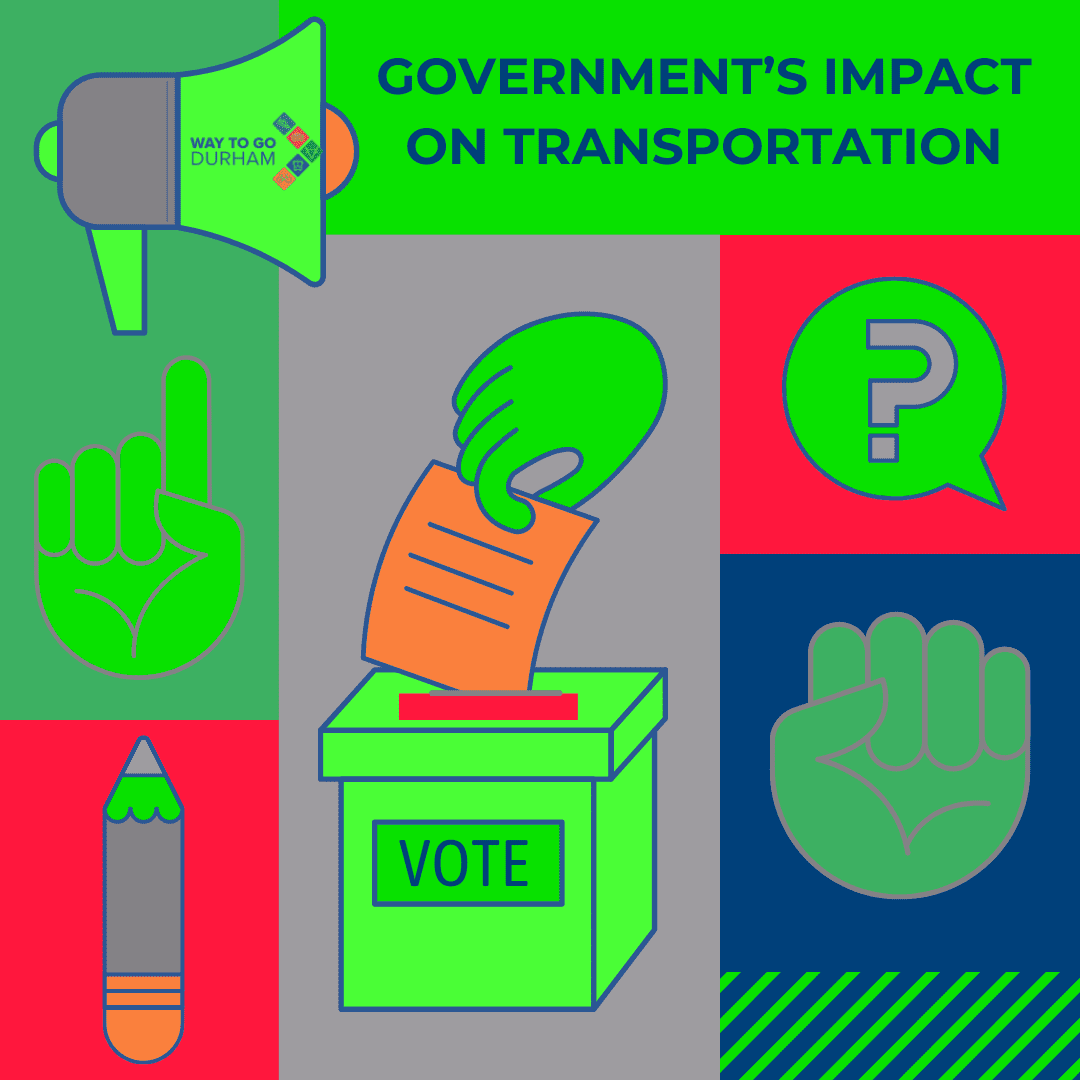We are a week away from Election Day on Tuesday, November 5. As we prepare to vote, we are reflecting on the Federal Government’s role, highlighting the key policies created and sharing how they impact the City of Durham.
Federal Government Role and How Durham is Impacted:
The United States Department of Transportation (USDOT) is a federal agency responsible for infrastructure and transportation policy development, administering safety regulations, funding public transit, providing security for transit systems (airports, trains, ferries, etc.), and allocating funds to support transit projects through grants and assistance programs.
The USDOT’s involvement in Transportation for the City of Durham is important because we receive nearly $6 Million each year to support GoDurham Transit and majority of our sidewalk/bike lane improvement projects have been funded by the Federal Highway Administration (FHWA). The $6 Million supports preventive maintenance, replacing engines and transmissions, and purchasing vehicles for our GoDurham ACCESS program. Recent projects in the City of Durham include 191 Alston Avenue (Capps to Riddle) sidewalk, and nearly eight miles of Neighborhood Bicycle Routes and CMAQ Bike Lanes. This agency is also responsible for emergency management during natural disasters and public health crises. During the COVID-19 pandemic and recovery, the City received over $40 million to support the operations of GoDurham
The Federal Government is obligated to keep transportation systems moving safely and sustainably nationwide. The USDOT’s mission statement is “To deliver the world’s leading transportation system, serving the American people and economy through the safe, efficient, sustainable, and equitable movement of people and goods.” Policies and priorities change from administration to administration, however, the purpose our nation moving will remain the same for this federal agency.
Each President selects their cabinet, an advisory body for the 15 executive departments, including transportation. The United States Senate must approve each cabinet member. I this role, the Secretary of Transportation oversees 55,000 employees and thirteen agencies to support every mode of transportation, including the Federal Aviation Industry (FAA), National Highway Traffic Safety (NHTS), Federal Highway Administration (FHWA), Federal Transit Agency, and the Federal Railroad Administration.
This administration focused on five policy areas: safety, jobs, equity, climate, and innovation. Key accomplishments include developing strategies to reduce roadway deaths and serious injuries (Vision Zero), delivering emergency relief funds to transit agencies nationwide during the COVID-19 pandemic and awarding over $9.5 billion to support 800 freelance transportation projects.
Policy and Implementation:
Transportation policy matters because it maintains safety standards, reduces environmental impact, expands accessibility and access, develops plans for emergencies, and advances technology for transportation systems. Additionally, transportation policy how funds are allocated to support a variety of transportation projects including outdated infrastructure, safety concerns, and providing jobs to support the work needed.
This law was the largest investment in restoring outdated bridges, transit systems, and passenger rail and investing in the future of electric vehicles. This plan includes a five-year approval of surface transportation programs within fiscal year 22 through budgetary year 26. Over $660 Billion was included in this package. Here is a breakdown of the costs:
- Federal Highway Administration: $365 billion
- Federal Transit Administration: $107 billion
- Federal Railroad Administration: $102 billion
- Federal Aviation Administration: $25 billion
- National Highway Traffic Safety Administration: $8 billion
- Federal Motor Carrier Safety Administration: $5 billion
- Maritime Administration: $2 billion
- Office of the Secretary of Transportation: $43 billion
Job Creation:
This bill is reported to bring 700,000 new jobs annually to support the work to rebuild America’s infrastructure to increase transportation safety and access for everyone. The jobs include 175,000 manufacturing jobs, 175,000 construction jobs, and 100,000 transportation jobs.
Climate:
A key goal for this administration is to reduce carbon emissions, and the IIJA increased the amount of American manufacturing of green technology by building electric vehicle (EV) charging stations nationwide. The goal is 500,000 EV chargers by 2030, with an investment of $7.5 billion over five years. A historic investment of $91.2 billion will support the growth of America’s railways and transit systems to increase safe and sustainable transportation by rail instead of by car.
Equity:
Historically, communities of color have suffered a lack of clean air due to their proximity to factories, railways, highways, and other sectors, which causes heavy air pollution. The practices aligned with the IIJA are dedicated to improving air quality by investing in our public transportation systems and transforming from diesel gas to electric hybrid vehicles. Additionally, these communities have suffered the economic impact of urban renewal, which has left many displaced and disconnected from economic opportunities. This law created a grant called Reconnecting Communities, providing $1 billion to fund the planning, design, and reconstruction of street grids, parks, or other infrastructure for communities like these.
Access:
The IIJA emphasizes that our nation’s infrastructure was not built to allow persons with disabilities, such as limited mobility or visual or hearing impairments, to navigate easily. This policy created the All-Stations Accessibility Program, which includes over $1.7 billion to upgrade the accessibility of legacy rail fixed guideway systems for people with disabilities.
Safety and Vision Zero:
The IIJA invested $5 billion in the new Safe Streets and Roads for All program, which funds local efforts to reduce roadway crashes and fatalities through grants for planning and projects. Additionally, this legislation has opened up job opportunities such as Vision Zero Coordinators, staff who develop strategies to eliminate severe deaths and injuries on roadways, nationwide.
Impact in Durham:
The impacts of this legislation have benefited Durham, beginning with our new fleet of electric buses. The federal government purchased two out of eight of our electric buses, and we have 14 additional buses being ordered and most are funded by federal dollars. Our buses were paid for using the Federal Transit Administration’s Low Emissions-No Emissions Program, which covered 85 percent of the bus’s cost. The rest is covered by the Durham County Transit Plan. This program was started in 2015 and has continued under the IIJA, there is $91.2 billion in mandatory transit funding to support climate-friendly transportation.
Additionally, in April 2022, our department was awarded $10.8 million to rehabilite Durham Station..The $10.8 million in federal funding is allocated to cover 80% of this $13.5 million project; and the rest of the project will be funded by Durham County.
In September 2023, the North Carolina Metropolitan Mayors Coalition hosted a Rail Response Work Group event to raise awareness on new opportunities for railway travel in North Carolina. Thanks to funding from the IIJA, city-to-city travel by train has increased in North Carolina and is working to expand routes across North Carolina and other states. This is possible because of the IIJA’s work and the Amtrack expansion.
In February 2024, the City of Durham received a $4.8 million grant and an additional $4 million earlier this month from the U.S. Department of Transportation to fund 20 new high-speed charging stations for electric vehicles. The new chargers must be close to highways and located in underserved communities to expand access.
In March 2024, our department applied for federal funding from the USDOT for the Rebuilding American Infrastructure with Sustainability and Equity (RAISE) grant program, which is part of the IIJA. We submitted our application to improve pedestrian safety along Durham’s highest ridership route, the Holloway Street Corridor. The proposed improvements include increased pedestrian facilities, enhanced transit infrastructure, and safer access from intersecting streets.
We learned we were awarded the grant in July of this year, and the Secretary of Transportation visited Durham. Our department was awarded $12 million to support improvements for 33 intersections with new ADA curb ramps, two mid-block crossing improvements with new flashing beacons, and upgrades to all 32 bus stops with shelters, lighting, benches, bike racks, and more. Construction is expected to begin in 2026.
Transportation policy plays a crucial role in shaping society’s economic, social, and environmental landscape, making it a fundamental aspect of effective governance. Use this notation as a reminder to vote in this year’s election. Early voting ends on November 2 in North Carolina, and Election Day is November 5. Use the resources below to identify your voting plan.

